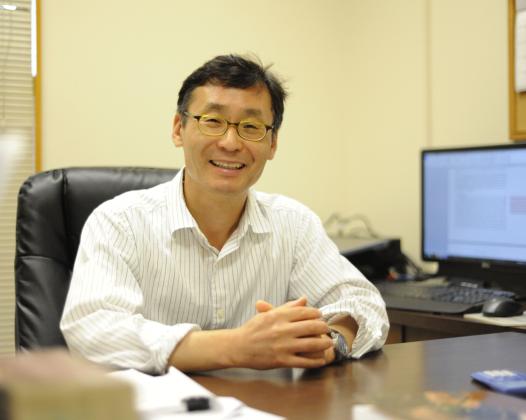
By Johnny Morgan
jmorgan@agcenter.lsu.edu
BOSSIER CITY — Identifying climate-smart strategies for water management is the goal of a three-year rice production study funded by the U.S. Department of Agriculture.
Changyoon Jeong, LSU AgCenter water quality specialist, will lead the study at the Red River Research Station in Bossier City and the H. Rouse Caffey Rice Research Station in Crowley
“Rice cultivation requires a significant use of water,” Jeong said. “That means that about one quarter to one third of the world’s developed freshwater resources are used for irrigating rice.”
Rice production faces increasing concerns of freshwater shortages due to salinization of water and drought events. Preserving water resources is also becoming increasingly urgent due to unpredictable precipitation and temperature fluctuations.
Jeong said traditional rice cultivation in the southern U.S. requires a sustained water level during the production cycle.
“But rice farmers are also looking for ways to cut production costs and they’re looking for the flexibility of field planting options — for example, upland rice,” he said.
Rice production is also a major emitter of methane gas in the flooded situation, he said.
The magnitude of the methane gas emission is closely related to the reduced condition facilitated by the water regime during rice cultivation.
In Louisiana, there are three basic water management practices in rice farming: delayed flooding, pinpoint flooding and continuous flooding, he said.
“Earlier research findings tended to emphasize that rice grain yield was highly related to the amount of water used,” he said. “But more recent studies have shown that rice grain yield could potentially be increased through alternative wetting and drying treatments.”
Jeong said this alterative water management program has the potential to reduce greenhouse gas emissions.
Recently, there has been increased interest in rice produced in furrow-irrigated fields, or row rice, in the southern region of the U.S. Row rice has been grown as an alternative rice culture for some time in areas facing water shortages but with much less acreage.
While studies have shown that furrow-irrigated rice can significantly save water use, it also gives rice farmers the flexibility to operate for an upland crop rotation with reduced field preparation and labor costs.
However, furrow-irrigated rice has generally showed similar or even lower yields as compared to traditional delayed continuous flooding rice production, likely due to increased nitrogen loss, weeds and insect issues, he said.
The integration of cover crops into rice production has been much less studied in the southern U.S. due to specific nature of dominant flood rice culture and subtropical-temperate climate factors that limit cover crops because of insufficient time to establish cover crops into a rice agroecosystem.
Additionally, there is increasing attention on how soil health relates to agricultural ecosystems, but the comprehensive soil health evaluations in furrow-irrigated rice under cover crop systems are limited.
This research is especially important for rice production in the midsouth Mississippi River Delta region, including Louisiana, Arkansas, Missouri, Tennessee, Mississippi and the east part of Texas.
“Our long-term goal for this project is to develop and improve a more agronomically flexible and environment-friendly rice cropping system by integrating furrow-irrigated rice and cover crop production,” Jeong said.
Jeong hypothesizes that integrating winter cover crops in rice production will enhance the soil health and productivity of rice agroecosystems while saving water and minimizing greenhouse gas emissions.
Therefore, cover crop residue addition to soil could stimulate emissions in the flooded paddy soil, but the proper water management strategies could suppress it.
